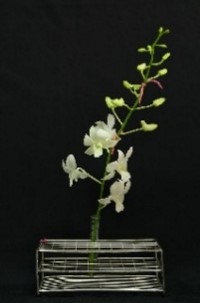ผลของน้ำนาโนบับเบิลและสาร 1-Methylcyclopropene ต่อคุณภาพของ กล้วยไม้หวายตัดดอกพันธุ์ขาวสนาน | Effect of Nanobubbles Water and 1-Methylcyclopropene on Qualities of Cut Dendrobium ‘Khao Sanan’
Main Article Content
Abstract
Presently, nanobubbles (NBs) water is widely used in agriculture.
This research aimed to study the effect of NBs water using 1-methyl
cyclopropane (1-MCP) for soaking an orchid inflorescence in a vase
using NBs water for extending the vase life and for delaying flower
senescence. The inflorescences of Dendrobium 'Khao Sanan' soaked in
1-MCP dissolved in NBs water at a concentration of 500 ppb (1-MCP-NBs)
were compared to the without-soaking and then holding in reverse
osmosis (RO) or NBs water. The result showed that the rate of water
uptake and the fresh weight change in all treatments reduced
throughout time. However, the inflorescences without soaking and
holding in RO water had the lowest water uptake concomitant with
a decrease in fresh weight change, and the open flowers had more
senescence resulting in the average of vase life of only 12.6 days.
The vase life of the inflorescences without soaking and holding in
NBs water showed no differences from that of soaking in the1-MCP-
NBs and then holding in the RO or the NBs waters. The average vase
life of these flowers was 15.6-16.6 days. Therefore, only usingthe NBs
water for vase solution, or soaking the whole inflorescences in
the 500 ppb 1-MCP-NBs water and then holding in the RO water
improved flower quality and extended the vase life of D. 'Khao Sanan' flowers.
ปัจจุบันมีการนำน้ำนาโนบับเบิล (nanobubbles; NBs) มาใช้ทางการเกษตร
อย่างกว้างขวางงานวิจัยนี้จึงศึกษาผลของการใช้น้ำ NBs ร่วมกับสาร1-methylcy-
clopropene (1-MCP) มาแช่ช่อดอกกล้วยไม้ หรือปักแจกันช่อดอกกล้วยไม้ในน้ำ
NBs เพื่อชะลอการเสื่อมสภาพและยืดอายุปักแจกัน โดยแช่ช่อดอกกล้วยไม้หวาย
พันธุ์ขาวสนานในน้ำ NBs ที่มีสาร 1-MCPความเข้มข้น 500 ppb ละลายอยู่
(1-MCP-NBs) เปรียบเทียบกับการไม่แช่น้ำ แล้วนำไปปักแจกันในน้ำ reverse
osmosis (RO) หรือน้ำ NBs พบว่า กล้วยไม้ในทุกการปฏิบัติ (treatment)
มีอัตราการดูดน้ำและการเปลี่ยนแปลงน้ำหนักสดลดลงตลอดระยะเวลา
การปักแจกัน โดยกล้วยไม้ที่ไม่แช่ในน้ำและปักแจกันในน้ำ RO มีอัตราการดูดน้ำ
น้อยที่สุดสอดคล้องกับการเปลี่ยนแปลงน้ำหนักสดที่ลดลงมากที่สุด และดอกบาน
เสื่อมสภาพมากที่สุด จึงทำให้มีอายุปักแจกันเพียง 12.6 วัน ในขณะที่กล้วยไม้
ที่ไม่แช่น้ำและปักแจกันในน้ำ NBs มีอายุปักแจกันไม่แตกต่างจากกล้วยไม้ที่แช่น้ำ
1-MCP-NBs แล้วปักแจกันในน้ำ RO หรือน้ำ NBs มีอายุปักแจกันเฉลี่ยอยู่ระหว่าง
15.6-16.6 วัน ดังนั้นการใช้น้ำ NBs ปักแจกันช่อดอกกล้วยไม้เพียงอย่างเดียว
หรือการแช่ดอกกล้วยไม้ทั้งช่อด้วยน้ำ 1-MCP-NBs ที่ความเข้มข้น 500 ppb
แล้วปักแจกันในน้ำ RO ส่งผลให้กล้วยไม้หวายพันธุ์ขาวสนานมีคุณภาพดีและ
ช่วยยืดอายุปักแจกันได้
Downloads
Article Details
References
กระทรวงเกษตรและสหกรณ์. (2547). เอกสารวิชาการกล้วยไม้. (น.152) กรุงเทพฯ: กรมวิชาการเกษตร.
ณัฐชัย พงษ์ประเสริฐ, พนิดา บุญฤทธิ์ธงไชย, และวาริช ศรีละออง. (2555). การใช้ฟองก๊าซ 1-MCP ขนาดไมโครและนาโน: เทคนิคใหม่ในการชะลอการสุกของกล้วยหอม. วารสารวิทยาศาสตร์เกษตร, 43(2), (พิเศษ), 61-64.
นริสา อุทัยฉาย. (2546). ผลของ 1-methylcyclopropene ที่มีต่ออายุการปักแจกันและคุณภาพดอกกล้วยไม้สกุลหวาย. วิทยานิพนธ์ปริญญามหาบัณฑิต, มหาวิทยาลัยเกษตรศาสตร์, กรุงเทพฯ.
เปมิกา พรหมแก้ว, ณัฐชัย พงษ์ประเสริฐ, และวาริช ศรีละออง. (2558). ผลการใช้ฟองก๊าซ 1-MCP ขนาดไมโครต่อการชะลอการเสื่อมสภาพของกล้วยไข่โดยวิธีการฉีดพ่น. วารสารวิทยาศาสตร์เกษตร, 46(3), (พิเศษ), 841-844.
สายชล เกตุษา. (2531). เทคโนโลยีหลังการเก็บเกี่ยวของดอกไม้. (น. 291) กรุงเทพฯ: สารมวลชล.
สายชล เกตุษา และนริสา อุทัยฉาย. (2543). การปรับปรุงคุณภาพของกล้วยไม้หวายเพื่อการส่งออกโดยใช้ 1-methtlycyclo
propene : รายงานผลการวิจัยฉบับสมบูรณ์ ทุนอุดหนุนวิจัย มก. ปีงบประมาณ 2543.กรุงเทพฯ: มหาวิทยาลัยเกษตรศาสตร์.
Agarwal, A., Ng, W. J., & Liu, Y. (2011). Principle and applications of microbubble and nanobubble technology for water treatment. Chemosphere, 84(9), 1175-1180.
Atsuko, O., Lekkhum, P., Kaewlek, A., Pongprasert, N., & Srilaong, V. (2016). The application of microbubbles technology in combination with 1-MCP to extend vase life of Dendrobium cv. 'KaeawYok'. Agricultural Sci. J., 47(3), 313-316.
Hew, C.S., & Yong, H.W.J. (2004). The physiology of tropical orchids in relation to the industry (2nd ed.). (p. 370). Singapore: World Scientific.
Liu, S., Oshita, S., & Makino, Y. (2014). Stimulating effect of nanobubbles on the reactive oxygen species generation inside barley seeds as studied by the microscope spectrophotometer. International Conference of Agricultural Engineering, 6-10.
Liu, S., Oshita, S., Makino, Y., Wang, Q., Kawagoe, Y., & Uchida, T. (2016). Oxidative capacity of nanobubbles and its effect on seed germination. ACS Sustainable Chemistry & Engineering, 4(3), 1347-1353.
Mahakarnchanakul, W., Klintham, P., Tongchitpakdee, S., & Chinsirikul, W. (2015). Using sanitizer and fine bubble technologies to enhance food safety. In FFTC-KU International Workshop on Risk Management on Ahrochemicals through Novel Technologies for Food Safety in Asia (pp. 1-19).
Reid, M. S., & Wu, M. J. (1992). Ethylene and flower senescence. Plant growth regulation, 11(1), 37-43.
Sisler, E. C., & Serek, M. (1997). Inhibitors of ethylene responses in plants at the receptor level: recent developments. Physiologia plantarum, 100(3), 577-582.
Sisler, E. C., Dupille, E., & Serek, M. (1996). Effect of 1-MCP and methylenecyclopropane on ethylene binding and action on cut carnations. Plant Growth Regulation, 18(1), 79-86.
Taiz, L., & Zeiger, E. (2002). Plant physiology. (p. 690). Sunderland, USA: Sinauer Associates.
Ueda, Y., Tokuda, Y., Nihei, N., Yajima, Y., & Yabuki, T. (2014). Fleshness Enhancement of cut flowers by using water containing fine bubbles int. Japanese Journal of Multiphase Flow, 28(3), 340-344.
Veen, H. (1983). Silver thiosulphate: an experimental tool in plant science. Scientia Horticulturae, 20(3), 211-224.

